Jacob’s Pillow opens its season with a Gala performance.
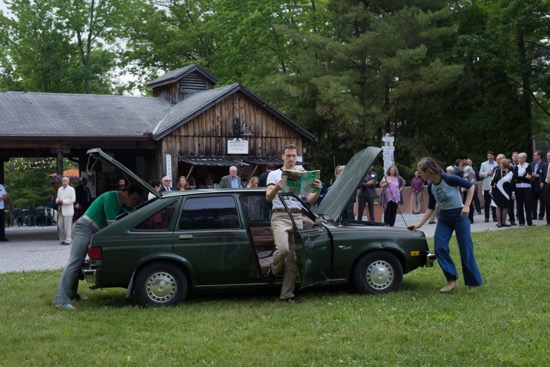
Zhenya Cerneacov, Brodie Stevenson, and Mairéad Filgate of Throwdown Collective entertain the cocktail-hour crowd at the Jacob’s Pillow Gala. Photo: Brooke Trisolini
It was only when I was leaving the Jacob’s Pillow Gala that I started to consider this dance establishment’s 85th anniversary celebration in terms of transformation and the breaking of boundaries. It could have rained and didn’t, but there were umbrellas-in-waiting in the bags we were given, also pens (which could come in handy for adding your name to one or more of the forty-one silent-auction items on display in the huge dinner tent). I’ve lost my menu for the elegant dinner, but I know that I would certainly never have guessed what one of the comestibles was, so craftily was it altered.
I’ve been thinking recently about palimpsests, although the examples that I’m about to offer are suspect; you can’t exactly discern traces of the old original through the present reality. However, I look at the immense Jacob’s Pillow lawn housing a tent for eating and another for dancing yourself crazy and I see the lineaments of the original dusty parking lot beneath them. I look at the main theater’s glowing wood walls where the paintings of Jacob’s Pillow founder Ted Shawn and his onetime partner Ruth St. Denis hang and remember the days when all that stood in their place was the former barn’s outer structure, through whose boards the wind used to sneak.
In that theater, on June 17, 2017, we see daring and courage displayed in a number of ways—not just through the projected photographs commemorating the previous eighty-four seasons, but through the live appearances before us.
This year, for instance, the Pillow’s annual honoree is Liz Lerman, and she received that recognition with a wise statement about art and life. She founded her D.C. based Dance Exchange in 1976 and ran it until 2011, and although she has maintained a distinguished and variegated teaching career ever since, I think back to the creative ways in which she used to mingle young dancers with older ones. There was not a trace of condescension and much understanding in her approach to the company members whose hair happened to be gray. As I recall, she was the first choreographer to think of dancers as not all generically young and skinny.
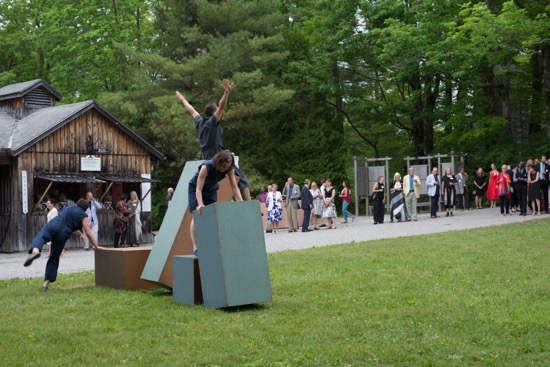
Zhenya Cerneacov, Mairéad Filgate, and Brodie Stevenson of Throwdown Collective in their Boxset. Photo: Brooke Trisolini
At the Gala, the three members of Toronto’s Throwdown Collective (Zhenya Cerneacov, Mairéad Filgate, Brodie Stevenson) perform, as is their wont, not only on the stage of the Ted Shawn Theater, but on the grass outside. Although these two men and one woman have each danced with a number of Canadian contemporary dance companies, their collective “product” involves witty athletic maneuvers on and off objects. I must have been elsewhere on the premises when they performed their 2013 1981FM on a parked Chevy Chevette, but I watch with pleasure how nervily they manipulate, toss down, fall onto, dive past, and vault over not only one another but four differently-sized boxes (Boxset, 2011). They don’t offer circusy manners or pause for applause; this is just, so to speak, their way of life: keep moving, keep your eyes open, be prepared for change—not bad advice these days.
Sara Mearns, one of the New York City Ballet’s most fascinating principal dancers, has begun to venture outside the Balanchine orbit. Recently she collaborated with a stellar postmodernist, Jodi Melnick, and this June appeared as a guest artist with the Isadora Duncan Dance Company, directed by Lori Belilove. I would love to know how she came to connect with Company Wang Ramirez—specifically with its two directors, Honji Wang and Sébastien Ramirez, who met on the hip-hop scene in Germany and can imaginatively mix ballet (which Wang once studied), break dancing, and martial arts.
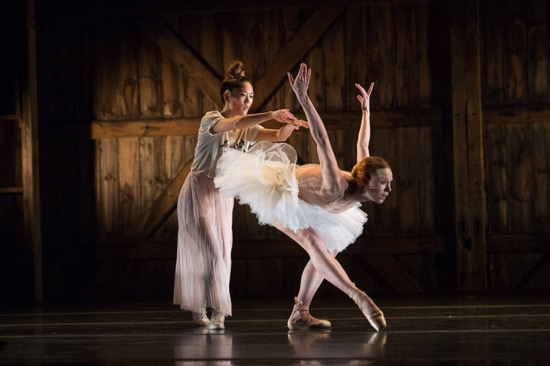
Honji Wang (L) and Sara Mearns in Wang Ramirez’s No1. Photo: Christopher Duggan
Wang and Mearns come together in a duet choreographed for the occasion by Wang and Ramirez. It’s called No1. Jacob’s Pillow director Pamela Tatge introduced it as a preview, which gives one hope for a No2. Wang takes the stage alone with a barre that looks more like a fence. She’s garbed in a t-shirt, shorts, and sneakers, but over these she wears a long, translucent, somewhat tatty white skirt. The attire doesn’t stop her from slippery moves. But when Mearns arrives in a short practice tutu and starts doing her pliés at the barre (on which Wang tries lying belly-down), Wang shadows her moves, but without the ballerina turnout; her feet bat out tendus parallel to each other. And just before Mearns lugs the barre offstage, the two women step, fleeted-footed, into turns in attitude.
Offhandedly—without showing off for our benefit— they display their different senses of the same steps, sometimes in synchrony, sometimes patterning them as a question-and-answer session. We hear their breathing, although at some point high voices join in, and Mike Faba dims the lights a bit. Mearns gets down with the undulating steps, and eventually the women touch, tangle, embrace. Mearns arches over Wang’s back, and gets dragged along (no pointy-toed cavalier needed to rescue this strong woman).
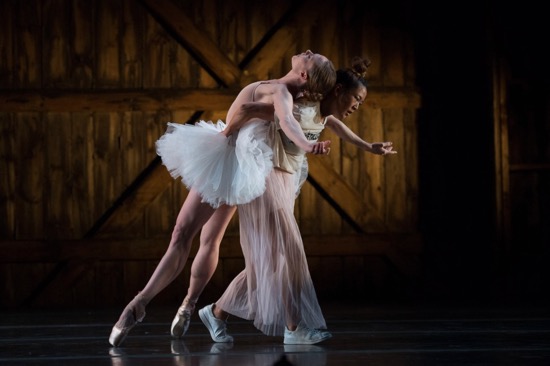
Honji Wang carries Sara Mearns away. Photo: Christopher Duggan
The little pas de deux celebrates difference as well as challenging it, whereas two members of the Miami City Ballet (at the Pillow’s Ted Shawn Theater through June 25) make falling in love the virtuoso act it sometimes is. Jennifer Lauren (a principal dancer in the company) and Chase Swatosh (a soloist) perform the duet created by Kenneth MacMillan for London National Theatre’s 1990s revival of Rodgers and Hammerstein’s musical Carousel and staged by Stacy Caddell. I’m assuming this is the Act II pas de deux that features the as-yet-unredeemed hero’s daughter and a bumptious young boy. Set to pianist Franco Rennó’s expert playing of a medley of tunes from the show, the choreography reveals Lauren’s initial shyness, and the growing eagerness and displays of virility via leaps and spins by Swatosh (an alumnus of The School at Jacob’s Pillow). As is often the case with MacMillan’s choreography, some of the encounters between the two suggest amorousness with a touch of violence, and the two dancers reveal both marvelously.
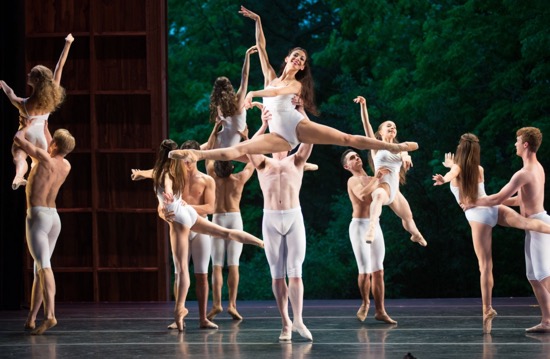
Students in Jacob’s Pillow’s Ballet Program in Bruce Wells’ Illustrious Beginnings. Photo: Brooke Trisolini
The program in the theater ends, appropriately, with a display of the students enrolled in The School at Jacob’s Pillow’s Ballet Program (directed by Anna-Marie Holmes). After the piece, Illustrious Beginnings, is over, and Tatge returns to the stage, her announcement that these twenty-one young dancers have learned Bruce Wells’ choreography in just four days draws gasps from the audience.
Kudos to the twenty-one, but also to the preparation Wells must have done in advance and to his rehearsal procedures. Big, clear moves assure that the stage picture looks tidy and attractively designed, while the fact that the women’s hair is unbound provides a touch of spontaneity. To pretty music by PARAMITA HE Xun Tian (a bit too sappy for me), Wells shows us what the female dancers can do on pointe and how well-selected men can spin and bound in aerial displays. But what impresses me most in the ensemble passages is the fact that the choreography doesn’t always foreground the most finished dancers. Lines and groups shift so we spectators have a chance to focus on every one of these would-be professionals, who glow with enthusiasm and dance as if their lives depend on their making every onstage moment perfect.
Just to remind us what this venerable summer festival (ongoing through August 27th) and school provide outside of the studios and theaters, the immense barn doors at the back of the stage slid open as Illustrious Beginnings was winding down, revealing the June trees behind it radiant in late afternoon sunlight. The audience, of course, gasped again. Green for the growing season of plants, young dancers, artful creations, and, yes, transformations.

Your comments about Throwdown Collective’s dance on a Chevy Chevette reminded me of Ginette Laurin’s work for the 1986 Expo in Vancouver, where one of her dancers dove headlong through the passenger window of a Chevy, did something unseen inside only to catapult out the driver’s side — I still remember gasping at the trick.
Oh those Expos in Vancouver and Montreal! I, too, remember Laurin’s daring and Louise Lecavalier hurling herself through the air in works by Éduard Locke. I think it was back then that I was surprised by choreographers presenting themselves in hour-long solos.
Love this, the mood, the writing, the air of festivity mixed with nostalgia, a totally charming post, thank you Deborah.